On November 6, 2020, French Company Naval Group has delivered the Suffren Barracuda-class nuclear-powered attack submarine (SSN) to the French Armament Procurement Agency (Direction Générale de l'Armement) at the Toulon naval base, in France. Intended for the French Navy, the Suffren is the first in a series of six SSN that will gradually replace the submarines of the Rubis-class.
Follow Navy Recognition on Google News at this link
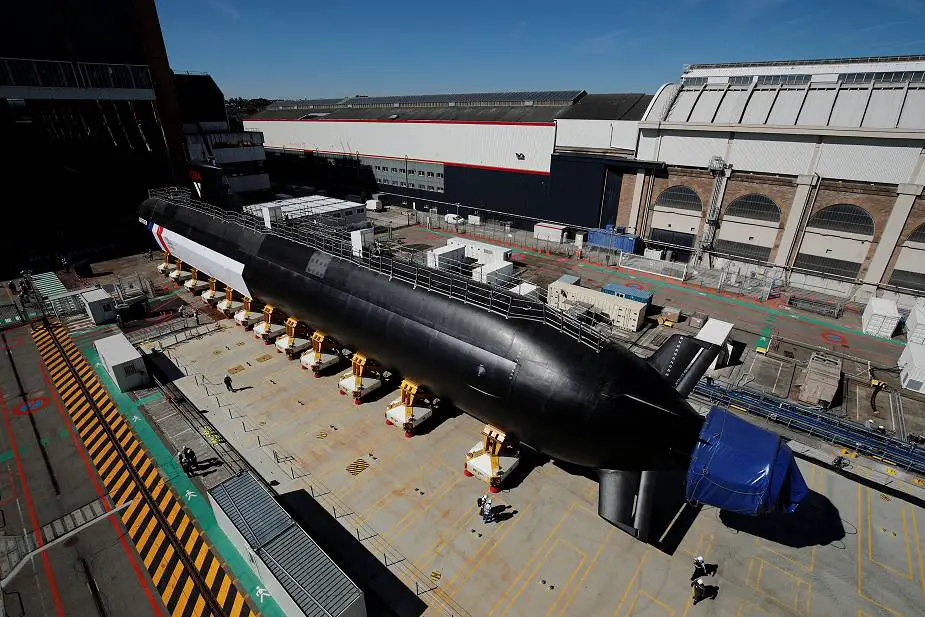 Transfer of the Suffren Barracuda-class submarine on the 5th of July, 2020. (Picture source Naval Group)
Transfer of the Suffren Barracuda-class submarine on the 5th of July, 2020. (Picture source Naval Group)
The Rubis-class is a nuclear attack submarine operated by the French Navy. The class comprises six vessels and they are the most compact nuclear attack submarines to date.
The first of the French SNA (Sous-marins nucléaires d'attaque - Nuclear Attack Submarine) Rubis class nuclear submarine was launched in 1988. The submarine has a displacement of 2,400 tons, a length ogf 73.6m, a beam of 7.6 m, and a draught of 6.4 m. It can reach a top speed of 25 knots (46 km/h; 29 mph).
The Rubis-class submarines are powered by two turbo-alternators; one main motor (with an emergency electric motor); one CAS 48 pressurized water-cooled nuclear reactor rated at 48 MW; one Jeumont-Schneider auxiliary diesel-electric motor, providing a top speed of 25 knots. The Rubis-class submarines 48 MW reactor needs no refueling for 30 years. Armament consists of Aerospatiale SM 39 Exocet anti-ship missiles launched from four 533 mm torpedo tubes; ECAN L5 Mod 3 dual-purpose torpedoes; or up to 32 FG 29 mines carried in lieu of torpedoes.
Launched in 1998 by the French Defence Procurement Agency (DGA), the Barracuda program renews the submarine component of the French nuclear deterrence capability consisting of six Rubis-class submarines that entered service in the early 1980s. The associated development contract was notified at the end of 2006. More than ten years of studies were required to define a submarine that meets the French Navy's operational requirements. This first delivery is the beginning of a phase leading to the qualification of this new class.
The delivery of the six submarines will take place over a decade. With a lifespan of more than 30 years, the Suffren-class submarines will be the backbone of the French submarine forces until at least 2060, making it one of the major weapon systems of this century.
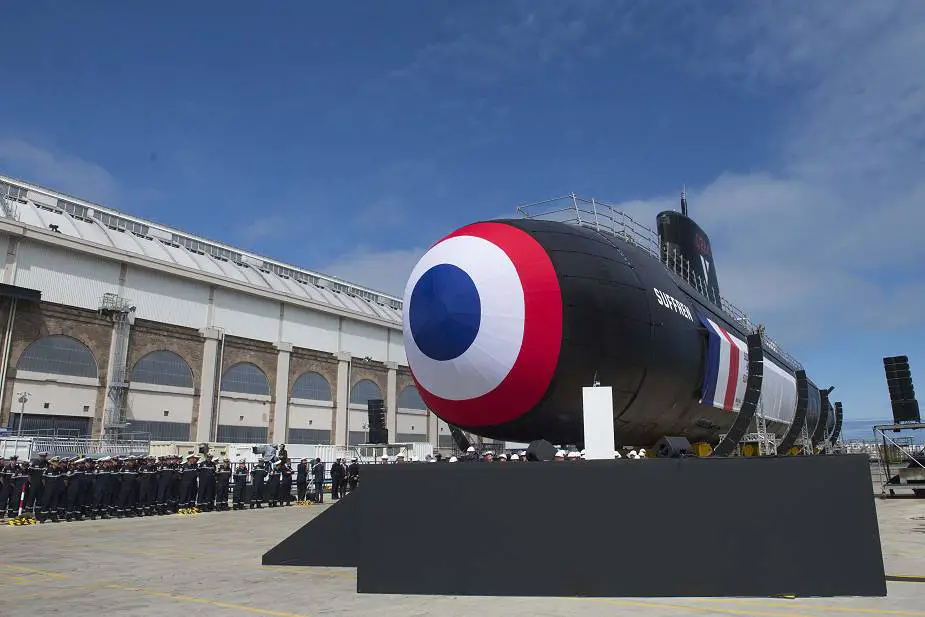
Naval Group launches on July 12, 2019, in Cherbourg, the Suffren, the first of a series of nuclear submarines of attack (SNA) of the last generation during a ceremony presided by the President of the French Republic Emmanuel Macron. (Picture source Naval Group)
The construction of these Barracuda submarines mobilizes a wide range of exceptional know-how in the most advanced technologies.
Among these, the very special steels, underwater acoustics performances, and the weapon systems make the SSN Barracuda one of the most efficient submarines in the world.
The Barracuda submarines, with their navigation and communication means and their centralized and automated control are also more maneuverable and mobile. Another major innovation is the optronic mast, which replaces the telescopic mast, ensuring a better collection of visual information and better sharing of this information among the crew. This new feature, combined with advanced detection capabilities, guarantees the superiority of Barracuda submarines in their intelligence missions.
The Barracuda series also offers the French Navy a real combat superiority with, for the first time, a deep strike capability thanks to MBDA naval cruise missiles (NCM). They can also use the Naval Group new Naval Group heavy torpedo F21 as well as MBDA SM39 missiles. The Barracuda submarines also enable the discreet and enhanced deployment of special forces.
This technological and capability leap is the result of more than twenty years of collective work between Naval Group and hundreds of partners of the European defence industrial and technological base. A total of 2,500 men and women (including around 800 from Naval Group subcontractors) are contributing to the design and production of the Barracuda submarines.
All Naval Group sites are currently mobilized for the next five Barracuda submarines. The second of the Barracuda series, the Duguay-Trouin, whose sections will be fully joined by the end of this year, will be delivered in 2022. The third, the Tourville, is being integrated at the side of the Duguay-Trouin. At the Naval Group site in Nantes-Indret, the assembly of the propulsion system and of the nuclear boiler module of the fourth, the De Grasse, is also underway. Finally, Naval Group teams have begun forming the first elements of the hulls of the fifth and sixth submarines, the Rubis and the Casabianca, as well as elements of their nuclear boiler modules.
The infrastructures at the Toulon naval base have been modernized to accommodate this new generation of submarines: "We are ready and very proud to work on the through-life support of the Suffren in Toulon," said Vincent Vimont, Director of the SSN Operational Maintenance Program at Naval Group.
The project started with definition studies in 2014 and mobilized around 200 people from the Naval Group and from 15 subcontractors. Two other basins will also be modernized in the coming years. The teams at the Naval Group Toulon site, specialized in the through-life support of submarines, have been trained in the new technical specifications of the submarine and in the use of the new facilities. They are now qualified to carry out maintenance operations on the Suffren and her sisterships.
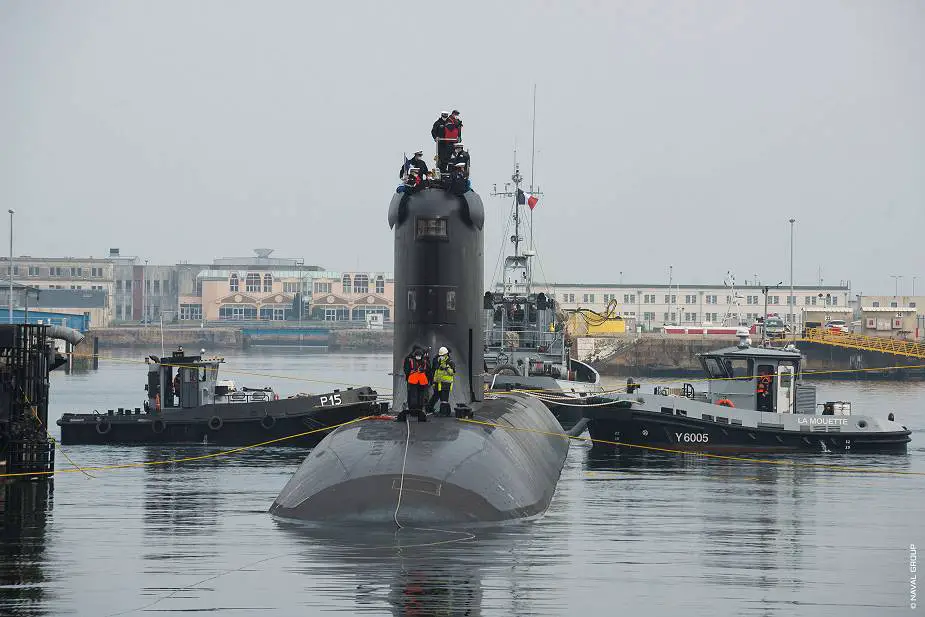
Suffren Barracuda-class submarine for the French Navy begins his sea trials. (Picture Source Naval Group)
The sea trials – conducted by the DGA as the ship is manned by the French Navy – aim at proofing the Suffren capacities and the conformity to the ship specifications in order to qualify the Barracuda submarines. These sea trials represent an intense validation phase for a nuclear submarine's on-board installations. The operations conducted progressively over several test campaigns have made it possible to ensure that the vessel is watertight underwater, that she can be properly maneuvered, but also to assess the performance of the combat system, tactical weapons and all the high-tech equipment on-board. These tests were concluded with the firing of the SM39 missile on September 23, and of the naval cruise missile (NCM) on October 20. The NCM is a major advantage of the Barracuda submarines over their predecessors: French submarines will now be able to fire underwater and hit a land-based target several hundred kilometers away. This new capability guarantees the technological superiority of French Navy ships.
In April 2020, the Suffren Barracuda-class started his sea trials, enabling the French Defence Procurement Agency (DGA) and the French Navy to test the performances of the submarine at sea before her delivery later this year. This series of sea trials followed the divergence of the nuclear reactor which took place in December 2019 and the dock tests carried out since the launch of the submarine on July 12, 2019. The operations successively took place in the assembly hall as well as in the dry and water-filled docks to test equipment and systems, such as the combat system. Trials are conducted by joint teams from Naval Group, TechnicAtome, and French authorities.
On October 20, 2020, the Suffren, the first-in-series of the six nuclear-powered attack submarines (SSNs) in the Barracuda program, successfully completed the test-firing of an MdCN (Missile de Croisière Naval) naval cruise missile from the sea near the DGA missile test center at Biscarrosse.
With a range of several hundred kilometers, the MdCN is tailored for missions against infrastructures of high strategic value. After the Multi-Mission Frigates (FREMM), the Suffren-class SSNs are the first French vessels to be equipped with this conventional deep strike capability. The ability to deploy the MdCN from submarines maintains the constant and undetected threat of a strike from the sea against enemy targets located far inland and very significantly increases the penetration capacity of French weapons in military theatres of operation.
During its trials in the Mediterranean, the Suffren also successfully completed a test firing of an Exocet SM39 underwater-launched anti-ship missile from the sea near the DGA missile test center on Île du Levant, as well as several test firings of the F21 heavy torpedo, a next-generation weapon that will ultimately be carried on all French Navy submarines.
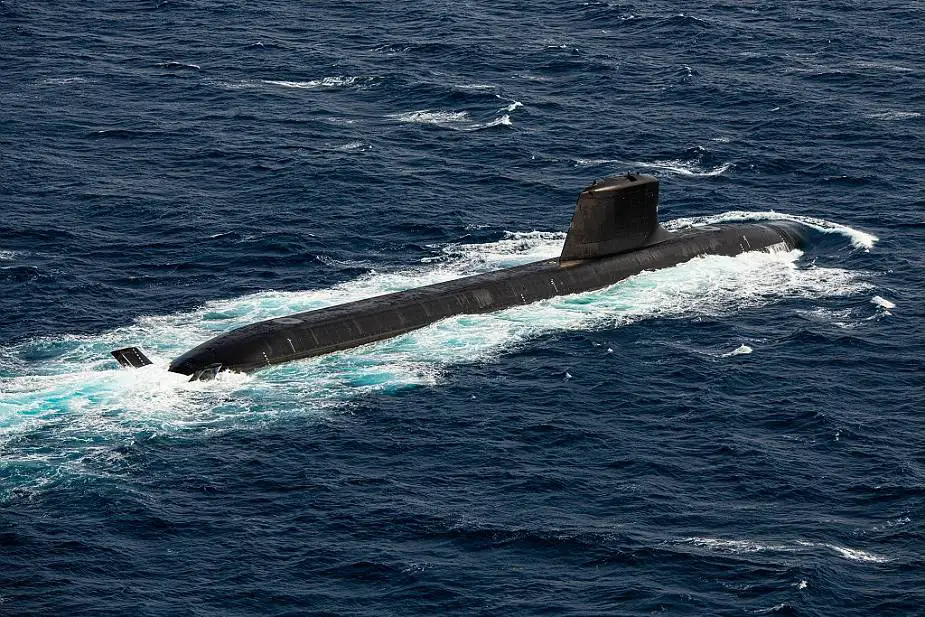
French Company Naval Group delivers the SSN Suffren to the French Procurement Agency (DGA) on November 6, 2020 (Picture source Naval Group)
The Suffren is one of the world’s stealthiest submarines. This discretion, combined with her advanced detection capabilities, guarantees her acoustic superiority. For the first time, thanks to the Suffren-class submarines, the French Navy will have a deep strike capability with MBDA's naval cruise missiles (NCM). The latest generation of SSNs also allows the discreet deployment of Special Forces underwater, in particular thanks to its "divers hatch" and the optional carrying of a dry deck shelter allowing for the deployment of underwater vehicles. More discreet, with increased autonomy and better capacities, maneuverable and mobile, the Suffren has the latest generation of systems, including a centralized and more automated driving.
The Suffren is powered by a nuclear propulsion system using a new hybrid design that provides electric propulsion for economical cruise speeds and turbo-mechanical propulsion for higher speeds. the submarine can reach a top speed of 25 knots (46 km/f; 29 mph) with an unlimited range of 10 years. It has a crew of 60 people including 12 officers and 48 sailors.
The armament of the Suffren-class submarine includes four 533mm torpedo tubes and 20 storage racks for various weapons including F21 Artemis heavy torpedoes, Exocet SM.39 Block 2 anti-ship missiles with a range of 50 km, SCALP naval cruise missiles with a range of over 1 000 km, and FG29 mines. Two mines can be carried per weapon rack.
Technical characteristics of the Suffren-class SSN:
• Surface displacement: 4 600 t.
• Underwater displacement: 5 200 t.
• Length: 99 m.
• Diameter: 8,8 m.
• Armament: naval cruise missiles (NCM), heavy torpedo F21, anti-ship missiles SM39, capacity to lay mines,
• Hybrid propulsion: pressurized water reactor derived from the nuclear boilers of the Le Triomphant-class SSBN and of the Charles-de-Gaulle aircraft carriers, two propulsion turbines, two turbine generators, and two electrical motors
• Immersion: deeper than 300 m.
• Crew: 65 people + special forces
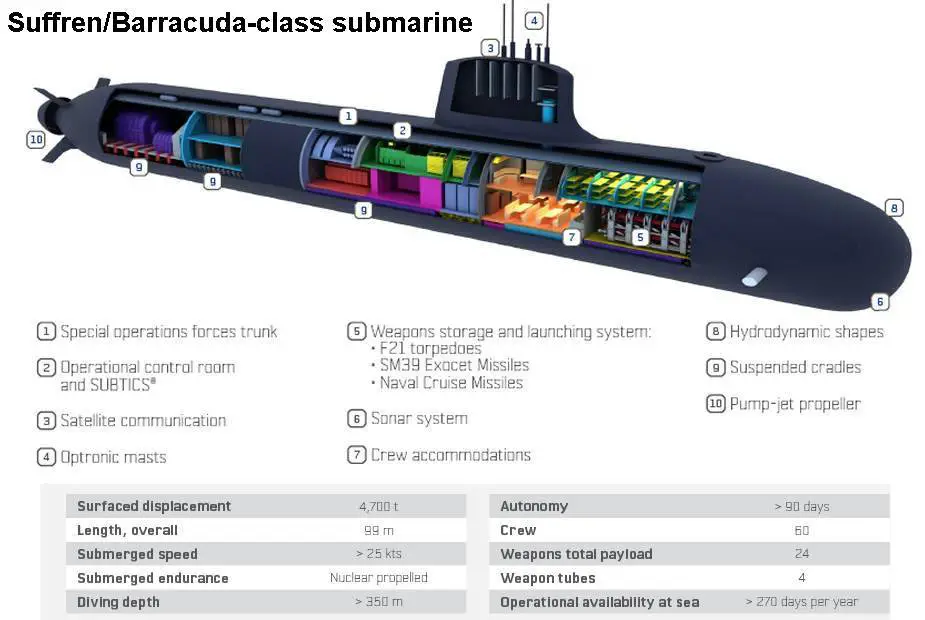
Technical features of Suffren Barracuda-class submarine for the French Navy (Picture source Naval Group)



